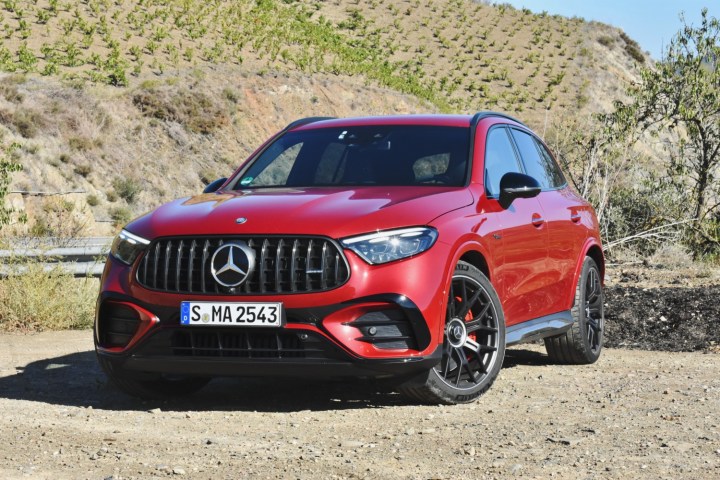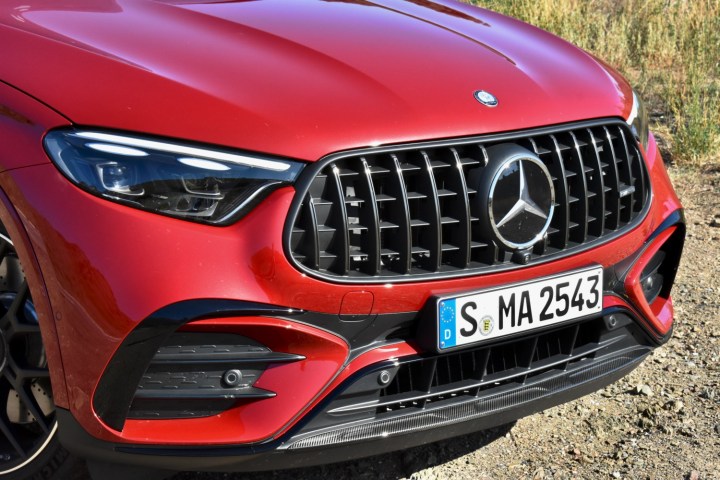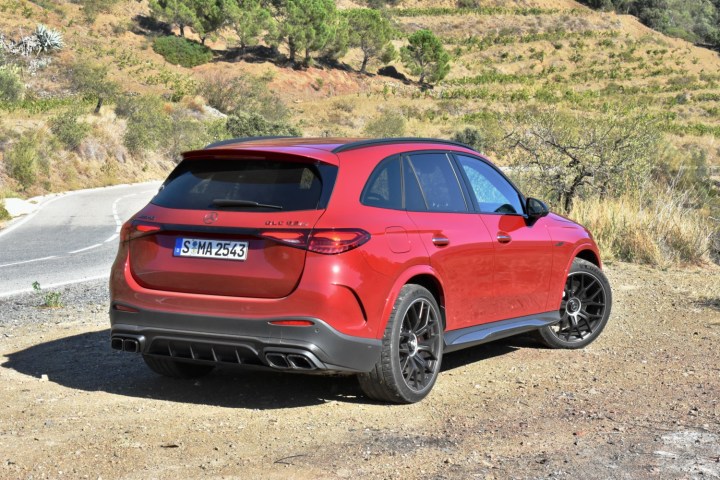
When it comes to electrifying performance cars, Mercedes-Benz believes there’s no silver bullet.
The automaker’s Mercedes-AMG performance division has already engineered EVs like the AMG EQE SUV and the S63 AMG E Performance sedan, a plug-in hybrid that pairs electric assist with one of the brand’s traditional V8 engines. AMG’s latest electrified model — a hot-rodded version of the GLC-Class compact crossover SUV and a rival to performance SUVs like the BMW X3 M and Porsche Macan — sits somewhere in between those extremes.
Arriving in showrooms in the second half of 2024 as a 2025 model, the Mercedes-AMG GLC63 S E Performance, as it’s formally known, is a plug-in hybrid like the latest S63 — but one that uses electric power to compensate for a radically downsized engine. Instead of a big V8 like the S63 and last-generation GLC63, it uses a more economical turbocharged four-cylinder engine. Instead of treating electrification like necessary medicine, this AMG plug-in hybrid embraces its possibilities.
Design and interior
The GLC63 applies subtle styling changes to an already subtle redesign of the base GLC, which debuted for the 2023 model year looking pretty much like its predecessor. To that nondescript base, AMG adds a new grille with its trademark vertical slats, larger front air intakes, a rear diffuser, prominent tailpipes, and some exterior badging. Only true car enthusiasts will likely notice these differences, which gives the GLC63 a bit of added cool factor.

Like other GLC variants, the GLC63 is available in standard SUV and coupe body styles. The term “coupe” traditionally refers to a two-door car, but Mercedes and fellow German automakers BMW, Audi, and Porsche have stretched that term to include four-door cars with low, sloped rooflines. These vehicles are still true coupes in the sense that they offer less rear headroom and cargo space than conventional SUVs.
The GLC63 applies subtle styling changes to an already subtle redesign of the base GLC.
In standard SUV form, the GLC63 offers comparable cargo space to similarly-sized luxury SUVs like the BMW X3 and Porsche Macan. That’s one of the great things about an AMG Mercedes: Underneath the performance upgrades, it’s still a regular car.
The interior follows a familiar but satisfying recipe. Mercedes’ current interior design theme looks sharp. The angled dashboard, freestanding screens, and large round vents give the cabin a distinctive look and convey that this isn’t an ordinary Honda or Toyota. AMG models get the expected performance-car callouts, including a mix of microfiber and Nappa leather upholstery and optional sport seats with added bolstering.
Tech, infotainment, and driver assist
The infotainment system carries over from non-AMG GLC models, meaning it includes a 12.3-inch digital instrument cluster and an 11.9-inch touchscreen. Both are freestanding, with the touchscreen angled slightly toward the driver to create a more cockpit-like feel, according to Mercedes. Wireless Apple CarPlay and Android Auto are standard as well.

The screen setup and underlying Mercedes-Benz User Experience (MBUX) operating system are similar to other recent Mercedes models, such as the S-Class and C-Class sedans. As in those vehicles, it’s hard to find fault with the interface, which uses what Mercedes calls a “Zero Layer” arrangement that eschews menu pages for small widgets displayed side by side, or the graphics. Instead of traditional dials, for example, the instrument cluster uses a cool wave pattern for the tachometer. Mercedes’ voice control is also excellent, so much so that we ended up using it by default instead of fiddling with the touchscreen.
It’s hard to find fault with the infotainment interface.
The GLC63 also adds a built-in data logger, dubbed AMG Track Pace, that can record lap times and data traces for things like steering angle and brake pedal use at racetracks. That kind of data can be useful for improving driving technique and shaving tenths of a second off lap times, but we doubt many owners will take a luxury SUV to a racetrack and make use of this feature.
Like the rest of the GLC lineup, the GLC63 includes expected driver-assist features like adaptive cruise control and lane-keep assist, but you won’t find any cutting-edge tech like the Drive Pilot system now rolling out in limited areas on the Mercedes S-Class and EQS. This car just isn’t about that. All of the tech in the GLC63 goes into making the driving experience more involving, not less.
Driving experience
A complex powertrain makes good use of both gasoline and electricity. It starts with a 2.0-liter turbocharged four-cylinder engine that by itself produces 469 horsepower and 402 pound-feet of torque, with a small electric motor to keep the turbo spinning at power-producing speeds. This makes it the most powerful series-production four-cylinder engine in the world, according to Mercedes.

The gasoline engine, which is coupled to a nine-speed automatic transmission, could easily power the car by itself, but Mercedes also included an electric motor mounted at the rear axle along with its own two-speed transmission and a limited-slip differential. A 6.1-kilowatt-hour battery pack allows for 107 horsepower of continuous output from this motor, or 201 hp in short bursts. Combined output is 671 hp and 752 lb-ft of torque, or 168 hp and 236 lb-ft more than the last GLC63 got from its 4.0-liter twin-turbocharged V8.
Mercedes says the GLC63 will reach 60 mph from a standstill in 3.4 seconds. For reference, the GLC63’s main rival, the BMW X3 M, gets 503 hp from a non-hybrid powertrain in top Competition form. But despite a major power advantage, the Mercedes is only 0.3 seconds quicker than the BMW. Both have top-speed governors, with the Mercedes limited to 171 mph and the BMW reaching 177 mph with the optional M Performance Package.
When unleashed, the GLC63 feels dramatic enough to justify the AMG badge.
Regardless, a sub-4.0-second run from zero to 60 mph is still impressive for any vehicle, let alone a luxury SUV. Also impressive is the array of hardware Mercedes used to make the GLC63 handle less like an SUV and more like a sports car. Adaptive suspension can be made luxuriously soft or sports-car firm, and an active roll stabilization system keeps the body from leaning over in corners. Rear-axle steering and beefed-up brakes (with 15.4-inch front and 14.6-inch rear rotors) are included as well.
Between the mix of gasoline and electric power, drive modes, and individual settings for things like suspension, steering weight, and regenerative braking, this is a car of many personalities. It’s possible to dial everything down and create a comfortable cruiser barely perceptible as a performance car, or drive in electric mode with all of the chassis settings in hardcore mode for a sporty EV-like experience. And if you select all of the most aggressive settings, you get an eager, snorting animal that feels like it’s tugging at its leash when you’re forced to trundle through a small town at low speeds.
When unleashed on a twisty road, the GLC63 feels dramatic enough to justify the AMG badge. But it’s not quite as sharp as conventional performance SUVs like the BMW X3 M and Porsche Macan, which saps confidence. The other German performance SUVs can feel smaller and lighter than they actually are, but not this Mercedes. And while the plug-in hybrid powertrain is an impressive technical achievement, it’s not exactly charming. Full-throttle acceleration doesn’t feel as intense as the numbers suggest, and instead of the classic sounds of an internal combustion engine or the stark silence of an EV, the GLC63’s soundtrack is an odd mix of muted exhaust sounds and whines and whistles from its many other mechanical components.
Gas mileage, electric range, and safety
Fuel economy and electric range estimates weren’t available at the time of publication, but it’s safe to say the GLC63 is more about performance than efficiency. And because it’s the only plug-in car in its competitive set, and the model it replaces had a twin-turbo V8 rated at just 17 mpg combined, the bar is pretty low.
Safety ratings are also to be determined, as the Insurance Institute for Highway Safety (IIHS) and National Highway Traffic Safety Administration (NHTSA) hadn’t released any for the latest GLC models at the time of publication. When those safety ratings do arrive, it’s unclear if ratings for lesser GLC models will carry over to the GLC63.
How DT would configure this car
Mercedes doesn’t offer many options beyond paint colors, wheels, and carbon fiber trim, but that’s not the only question to ask when considering an AMG GLC63. This is Mercedes we’re talking about, so this plug-in hybrid performance SUV will share a crowded showroom with other models sharing some major ingredients.
The same plug-in hybrid powertrain is used in the AMG C63 S E Performance sedan. That means you still get 671 hp, but in a lighter sedan body with a lower center of gravity. That sacrifices some cargo space, and rear-seat passengers will be a little less comfortable, but it’s the obvious choice when it comes to driving dynamics.

By the time the GLC63 reaches showrooms, Mercedes will also have an AMG GLC43 model available. This essentially ditches the electric part of the GLC63 powertrain, keeping the gasoline engine as a standalone power source. The GLC43 still boasts 416 hp and will do zero to 60 mph in 4.7 seconds, according to Mercedes. It’s not part of the electrified zeitgeist, but it may be easier to live with than the dauntingly complex GLC63.
The GLC63 represents a middle ground between AMG’s traditional performance cars and EVs. While it’s much more entertaining than AMG’s only current all-electric SUV — the AMG EQE SUV — it’s still not a replacement for the best internal-combustion performance SUVs. It checks boxes with a powerful gasoline engine and plug-in hybrid system, but in a way that makes the GLC63 feel like a placeholder until more engaging all-electric performance cars arrive.
Editors' Recommendations
- Mercedes-AMG EQE SUV first drive review: a better electric SUV
- Mercedes-Maybach EQS SUV is old-school luxury — electrified
- We need more 7-passenger EVs, but the 2023 Mercedes EQS SUV has room to improve
- Mercedes-Benz EQS SUV is a luxury SUV for the family
- Mercedes-AMG EQE proves performance EVs are here to stay


